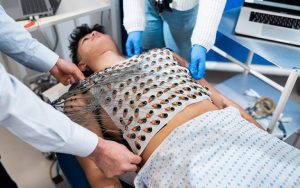[ad_1]
What biotechnological innovation should we not miss in December? A reusable jacket capable of mapping the flow of electrical signals at the heart…
Every year, there are between 4 and 5 million cases of sudden cardiac death worldwide. However, 80% of them are due to malignant ventricular arrhythmias. These result in a loss of contraction of the heart ventricles and very rapid and asynchronous pulsations, ultimately leading to a loss of blood flow and cardiac arrest. Until now, mapping the electrical activity of the heart to determine who is at risk has remained rare. This is due to the need to insert a catheter into the heart cavity, or to resort to expensive, single-use instruments whose implantation is time-consuming. To facilitate prevention, researchers from UCL (University College London) decided to combine electrocardiographic imaging (ECGI) and cardiovascular magnetic resonance (CMR) in a “simple” jacket…
A jacket embroidered with electrodes to measure cardiac activity
Conventional electrodes are made of silver-silver chloride (Ag/AgCl) and conduct the electrical signals surface using a metallic conductor, provided with a layer of electrolyte gel separating it from the skin. But these accessories are easily broken, non-reusable and can cause irritation. The technical feasibility and repeatability study of the ECGI-RMC jacket was detailed by UCL researchers in the Journal of Cardiovascular Magnetic Resonance of December 4, 2023. They announce in particular their preference for electrodes (256) based on textile, comfortable, foldable and washable. These square electrodes measuring 2 cm by 2 were manufactured at the École Nationale Supérieure des Arts et Industries (ENSAIT) in Roubaix, France. They are made of polyamide threads coated with silver and embroidered directly on a 100% cotton jacket.

77 participants between 30 and 78 years old were invited to wear it to carry out 3D digital models of their hearts. Tests performed at 3 Tesla showed good quality of the signal received after 50 machine washes, the equivalent of 250 patients. In the future, simplified use of the ECGI-RMC vest could help more effectively identify people in need of an implantable cardioverter-defibrillator. This small device slips under the skin to detect and correct abnormal electrical activity in the heart. Since the initial study, the vest has been worn by more than 800 patients. And this is probably just the beginning…
[ad_2]
Source link